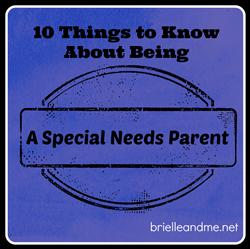Special Needs Series: Down Syndrome
By Guest Blogger Kristen Bagwell
As part of our special needs series, I wanted to cover a topic that is familiar to many of us: Down Syndrome. While this diagnosis has been around for more than 100 years, great strides have been made in the past 10 years as far as research and treatment options. Let’s begin with the facts.
Down syndrome (or Down’s syndrome) is a condition in which babies are born with an extra 21st chromosome. A typical genetic makeup equals 23 chromosomes from each parent, totaling 46 chromosomes. In a Down syndrome baby, there are 47 chromosomes present. The condition is named after John Langdon Down, the British physician who described the syndrome in 1866. In 1959, the condition was identified as a chromosome 21 trisomy by Jérôme Lejeune.
WebMD summarizes Down Syndrome as follows:
Down syndrome is a set of physical and mental traits caused by a gene problem that happens before birth. Children with Down syndrome tend to have certain features, such as a flat face and a short neck. They also have some degree of intellectual disability. This varies from person to person. But in most cases it is mild to moderate.
The occurrence of Down Syndrome is relatively rare, showing in approximately 1 in 800 births. Women over age 35 are at higher risk for having Down Syndrome babies, but most Down’s babies are born to women in their late 20’s – early 30’s. (This is simply because more women are having babies at this age as a group than the age 35+ moms.) Said differently, nearly 80% of Down Syndrome are born to mothers under the age of 35. Approximately 1 in 400 babies born to women over 35 have Down Syndrome. About 5000 babies with Down Syndrome are born in the US annually, and about 250,000 people with Down Syndrome are estimated to live within the general population.
Down Syndrome is not preventable because it is a genetic condition. However, it is typically diagnosed during pregnancy using one of several tests, giving the parents an opportunity to learn more and find support prior to the baby’s arrival. If it is not diagnosed before birth, it is typically found very shortly thereafter, and doctors will be able to perform a range of tests to create the best treatment plan for your child.
Medical professionals may use one or more of the following physical symptoms to diagnose Down syndrome: excess skin at the nape of the neck (often noted during pregnancy); decreased muscle tone at birth; flattened nose; separated joints between the bones of the skull; single crease in the palm of the hand or wide, short hands with short fingers; small ears and/or small mouth; and upward-slanting eyes.
If your baby is diagnosed, what does it mean for his or her life?
It is very difficult to know what to expect prior to your baby’s birth, when more tests can be performed. In general, though, people with Down Syndrome generally experience mild to moderate cognitive disabilities. The average IQ of Down Syndrome children is around 50, compared to 100 for non-Down children. A small number of cases can show a severe degree of intellectual disability, but these are the smallest percentage.
Down Syndrome may also bring increased risk for other impairments. For example, up to 50% of children with Down’s are also diagnosed with some form of congenital heart disease. Breathing, thyroid, gastrointestinal, and other issues may also become evident. Doctors can perform many tests when the baby is an infant to diagnose these kinds of physical ailments, but some may not be present until later in the child’s life.
Although Down syndrome is incurable, most children with the condition can grow up to have healthy, happy, productive lives. When children with Down syndrome receive professional and educational support, they can often graduate from high school and college, and go on to contribute in the work force.
WebMD advises parents of Down syndrome babies to:
Learn all you can about Down syndrome. This can help you know what to expect and how you can help your child.
Find out what type of financial help you can get by contacting your state’s Department of Developmental Disabilities.
Check into resources in your area. For example, many states provide free early-intervention programs for children with Down syndrome up to age 3 to help them get off to a good start.
Look into school options for your child. Federal law requires public schools to provide services to all children with disabilities between the ages of 3 and 21.
Alternative therapies for developmental and learning disabilities may also be used in the treatment of Down syndrome, and include a range of practices such as changes in diet plus dietary supplements, homeopathy, massage and yoga. Do your research, and ask your health care provider which types of additional therapies he or she would support.
Pamela Wilson, parent of a Down Syndrome child and Special Needs editor for Bella Online, gives some great real-world advice:
People with Down Syndrome are more like typically developing individuals than they are different…Children with Down Syndrome benefit from the same care, attention, and inclusion in community life that help every child grow. As with all children, quality education in neighborhood schools and preschools or at home is important to provide the child with Down Syndrome the opportunities that are needed to develop strong academic skills.
Although babies and children with Down Syndrome are early customers for extensive health evaluations, infant stimulation, physical therapy, communication enhancement, developmental evaluations, and other professional intervention, it is important to keep in mind that every child deserves to be surrounded by people who love, respect and admire all children.
For more information about Down syndrome, please check out these wonderful online sources:http://children.webmd.com/tc/down-syndrome-topic-overview
http://scfscience8.wikispaces.com/Down+Syndrome
http://www.downsyn.com/resources.php
http://children.webmd.com/tc/down-syndrome-topic-overview
Welcoming a baby with Down Syndrome by Pamela Wilson, Bella Online http://www.bellaonline.com/articles/art32534.asp
National Down Syndrome Society http://www.ndss.org
National Down Syndrome Congress http://www.ndsccenter.org
Diagnosis to Delivery: A Pregnant Mother’s Guide to Down Syndrome by Nancy Iannone and Stephanie Meredith http://downsyndromepregnancy.org
Local support:
http://www.dukechildrens.org/services/medical_genetics/down_syndrome_clinic
*Image credit: theinclusivechurch.wordpress.com







